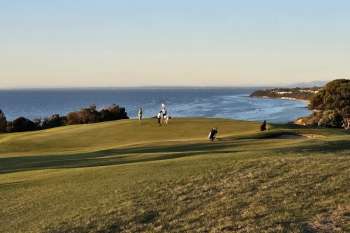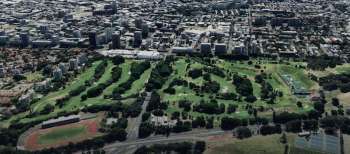Is Melbourne's Sandbelt over-rated?
While this article is unlikely to win me any new fans in my hometown, there are times when certain questions just need to be asked. And the burning question right now, for me, is whether Melbourne’s Sandbelt is over-rated?
Let me begin by backtracking to the Presidents Cup at Royal Melbourne in November. Beyond the assembling of 24 of the greatest golfers in the game, was a throng of respected, and otherwise, international golfing journalists and media, who descended upon Melbourne to cover the event and, in some cases, to sample Sandbelt golf. One such visitor was Californian author, blogger and design consultant Geoff Shackelford. Shackelford, like others, marvelled at the scale and architectural genius of Royal Melbourne, commenting on his blog that, ‘it’s morbidly depressing to think we won't see a tournament golf course this fascinating for a while.’
Shackelford also visited other prominent Melbourne courses during tournament week, but was far less flattering in his assessments. He remarked to an assembled audience at the Woodlands Golf Club that he was expecting a 'sand-belt' rather than a 'green-belt' when golfing in the city. He appreciated Kingston Heath and Victoria, but said of the others that, ‘I certainly understand after a drought that keeping grass around is a priority, but I was surprised at how much grass was in the roughs, particularly the long stuff. Dr. MacKenzie would not be pleased!’
Shackelford added that, ‘there is nothing better than hitting recovery shots off of crusty, sandy lies and what makes it all the more disheartening is the quality of the green complexes in Melbourne, which are so strong, so challenging and so demanding, that to not have a shot at a recovery because of thick lies almost makes the courses easier. After all, the real trouble at places like Commonwealth or Woodlands or Yarra Yarra is around the greens, especially when you play a silly shot.’
It wasn’t just the long roughs that disturbed him, but also the number of trees on many of our premier golf properties. As Shackelford noted, ‘besides having some really beautiful specimens lost in the mix of non-native trees, too many tree-lined fairways changes the look and feel of the courses and makes the greenkeeper's life a lot more difficult.’ He added that there was, ‘simply no good reason to have so many trees when you have such artistic and demanding green complexes.’
While these comments are likely to cause some disquiet within Victorian golfing circles, coming from such a respected architectural authority they warrant further examination. And again the question needs to be asked, how good is Melbourne really as a golfing city, and is the Sandbelt now, in 2012, at its peak?
The first thing that needs to be clarified here is that Melbourne is clearly the best golf city in Australia. Where it sits globally is less apparent. Given the current state of several courses, it would be a stretch to suggest that for quality it rivals the Hamptons on Long Island in New York or for quantity that it’s in the same league as London’s Heathland. I suspect that back in its day, however, the Sandbelt more than held its own against both regions.
Before properly analysing the virtues of Sandbelt golf, it’s important to clarify precisely what is meant by the term. The Sandbelt area technically incorporates public access layouts like Sandringham, Brighton and Cheltenham, as well as second-tier private clubs such as Spring Valley, Kingswood, Southern and Long Island. For most golfers, however, the Sandbelt refers to the eight major metropolitan clubs, Royal Melbourne, Kingston Heath, Victoria, Metropolitan, Peninsula, Commonwealth, Yarra Yarra and Huntingdale, who established a marketing body to promote the region and who benefit most from visitor play. For the sake of this article I’m throwing Woodlands into the discussion as well, for it has undeniable Sandbelt qualities and its bunkers were built by the same man, Mick Morcom, who also crafted Royal Melbourne, Kingston Heath and others. The fact that it’s not officially a member of the Sandbelt group is astonishing.
The problem with Sandbelt golf in 2012, as identified by Geoff Shackelford during his visit, lies both in the appearance and playing characteristics of several of its high-profile clubs. Even those who disagree with the premise of this article would find it hard to argue that any of Huntingdale, Commonwealth, Yarra Yarra or even Royal Melbourne East was currently in career best form. The first three no longer feel or play like traditional Sandbelt golf courses, and sadly there seems little appetite internally at these clubs for restorative change.
The poster child for sensitive restoration is the Victoria Golf Club, which arguably offers the purest Sandbelt experience at the moment. Rewind a decade or so and the situation was very different, and sadly all too familiar. Victoria had planted too many trees, in mostly the wrong spots, and had too much rough. Worse, its noted MacKenzie bunker shapes had been altered and were essentially unrecognisable.
Interestingly, club legend Peter Thomson had forewarned the club of this very predicament back in 1977, when he wrote a letter lamenting what he described as the change of ‘character and atmosphere’ taking place at Victoria as a result of tree planting and the removal of native wastes. Thomson describes how he first played the course when it was only 16 years old, and his memories were of, ‘large tracts of uncovered white sand apparent almost everywhere that fairways were not established.’
The letter explains, in some detail, his disappointment with the practice of formalising these native sandy roughs. Thomson says, ‘I note that going around the course today…areas that were once bare areas of white sand have at present been seeded…and water is extensively sprinkled to ensure rapid growth of grass. I wish to indicate that the ultimate extension of this treatment will eventually obliterate altogether all traces of base sand. Victoria will look no different to courses built along river flats further inland.’
Thomson’s letter provides an insight into the nature of early Sandbelt golf, as well as a reminder of the importance of proper custodianship on golden age architecture. It also offers clues as to where some neighbouring clubs went wrong. His views back then were very much in concert with those of Geoff Shackelford’s today, and he was equally concerned by what he saw as over-planting and the intrusion of trees into playing areas. Thomson describes the advantages of a tree-less landscape as allowing, ‘an abundance of light and hot sun (to) reach the fairways fostering the growth of desirable couch grass. The fairways were targets to be hit and to miss was to find the sand, which offered a mild and pleasant sort of penalty. Trees hardly ever came into mind.’
One can only assume that the younger Peter Thomson would have been delighted with the recent transformation at Victoria, as his beloved club shed a parkland disguise and returned to its earliest golfing roots by restoring their bunkering, revegetating their out-of-play areas and strategically removing hundreds of interfering trees. Shackelford himself was ‘blown away’ by Victoria, admitting that it ‘lived up to his expectations for what Sandbelt golf should be.’ Superintendent Ian Todd and his team deserve a great deal of credit here, for firming and de-cluttering the greens and green surrounds and for re-introducing a series of attractive, properly vegetated, sandy waste areas. Their current maintenance regime is really hard to fault and should provide benchmarks to other clubs on how the sandy terrain of south-eastern Melbourne is best managed and maintained.
Although some disagreement remains on the most appropriate description of Sandbelt golf, for those fortunate to play here on a regular basis the area is characterised by its firm, bouncy playing surfaces, its undeniably dramatic, naturalistic bunkering and by the remnant design ideals and philosophies of the great Dr. MacKenzie, visible across a number of courses. At places like Commonwealth, Yarra Yarra and Huntingdale the combination of too many trees, too much rough, prescriptive mowing and grassing patterns, disjointed bunkering schemes and uncharacteristic design changes have left the links these clubs once enjoyed with places like Kingston Heath, Royal Melbourne and Victoria seeming tenuous at best. As Shackelford correctly pointed out during his stay here, the bones at each of these courses is first-rate and it’s really the management and maintenance of the architecture, as well as the vegetation, that is keeping them for reaching their true potential.
Of the compromised layouts, Commonwealth has arguably survived the best from an architectural perspective but has clearly lost some of its Sandbelt ‘character and atmosphere’ because of its trees, its roughs (or more accurately its mowing patterns) and the lack of a coherent and uniform vegetation policy. A recent decision to extend its newly established Legend fairways right to the edges of the putting surfaces is a further departure from the established Sandbelt norms of providing golfers with variety around the greens via tight, bouncy fringes and aprons.
Like at Commonwealth, the trees at Yarra Yarra act to preserve the serenity of the property on the one hand, but badly cloud the architecture of the golf holes on the other. Yarra has dealt with a number of boundary issues over the past two decades and a rigorous planting program, together with a number of questionable design modifications, has relieved the course of both character and continuity. A restoration back to the barren sandscrape of the 1930s, and to Russell’s original design concepts, would be virtually impossible here, but a strategic culling of trees and the adoption of a uniform, and more indigenous, bunker style and vegetation program are essential if this course is to continue to attract Sandbelt visitors.
As we know, the first step on the road to recovery is to admit that you have a problem, and this is not easy for a proud, prestigious golf club. If Shackelford’s frank assessments or Thomson’s reminiscences don’t inspire a sense of nostalgia for true ‘sand-belt’ golf, perhaps the fact that each of the aforementioned clubs has fallen from inside Australia’s top 15 during the early 1990s, to somewhere between 24 and 36 (in 2010) will raise the alarm. Competition has certainly increased in the last twenty years, but stopgap measures are no longer a viable panacea for older clubs stuck in an aesthetic or agronomic malaise.
Perhaps it’s worth repeating Peter Thomson’s blunt warning to his fellow members back in 1977, when he said, ‘Lest it not be forgotten, Victoria is a ‘Sandbelt’ course... having seen countless courses of all classes in all parts of the world, I have come to the conclusion that courses showing substantial areas of white sand tend to be outstanding and that natural gift is such a blessing that it should be carefully preserved and encouraged.’
Clearly in the case of several Melbourne clubs, the white sandy blessing they were given at inception has been lost as they have evolved and somehow morphed from naturally sparse and sandy to atypically green and woody. The bare bones of great golf are still apparent all over the Sandbelt and as our Top 100 rankings next month will no doubt prove yet again, it is still the finest golf destination in Australia. The scary thought for competing areas is just how much improvement remains, as these closing remarks by Geoff Shackelford confirm. ‘When you consider the potential of those courses. When you look at the green complexes, when you look at the way they are so beautifully maintained, when you look at the bunkering… the bones essentially, then (Melbourne) should be the premium region for golf in the world.’
Darius Oliver, Architecture Editor
‘The most difficult thing in golf course design to get right is a really beautifully designed green complex with many hole locations and an artistry to it, that just sits in the ground the right way, works strategically, is challenging, is memorable, all those things that are hard to create with a green. So when you go to a course and you see that, and then the rest of the course doesn’t quite match the green it’s disappointing, and you want to point it out because some of these courses should be considered within the Top 50 in the world, and they’re just not because there are too many trees and too much rough.’ Geoff Shackelford 2011
'Apart from being a radical departure from the design principles, no thought has been given, I would guess, to the effect of these new tree plantings in say 10 to 20 years time. If these young saplings are to stay where they are now, some fairways will resemble Flinders Lane.’ Peter Thomson to the Victoria Golf Club, 1977
Back to NewsMore News
Report reveals golf's $3.3 billion contribution to Australia
AGIC report reveals total annual benefits to the Australian community, economy and environment from golf.
Cape Wickham Links – The Inside Design Story
Co-designer Darius Oliver reveals the truth behind the design of Australia’s premier modern golf course
Min Woo Lee signs up for Aussie PGA title defence
Reigning champion locks in the defence of his title at Royal Queensland Golf Club in November
Have your say on the future of Moore Park Golf
Golfers unite – another one of our cherished public access golf courses is under threat




